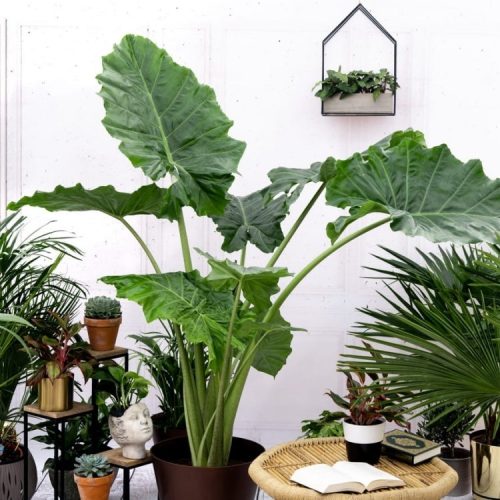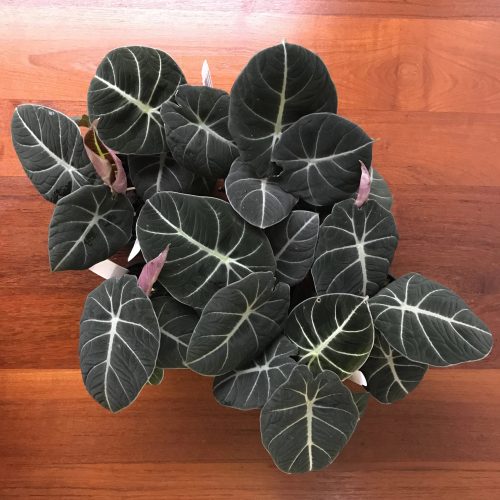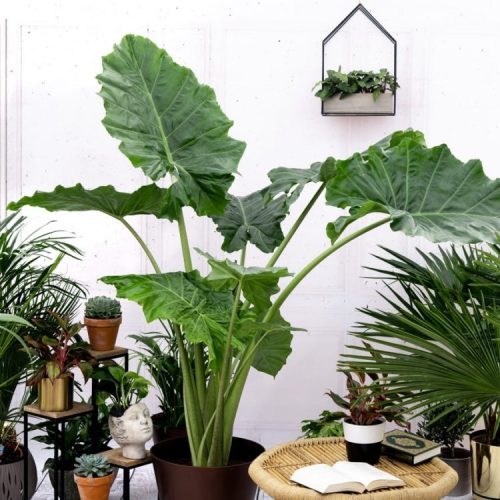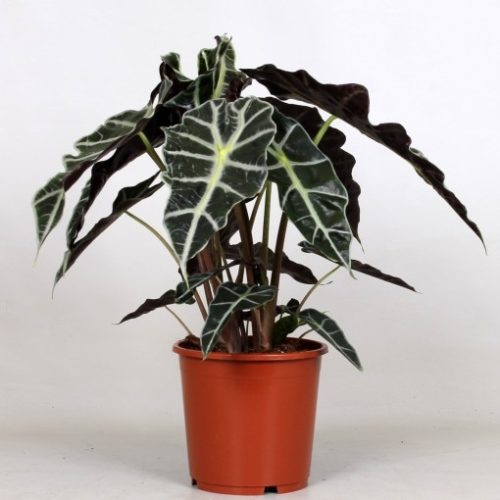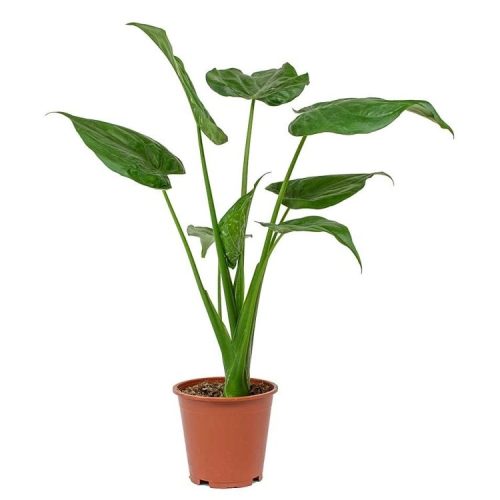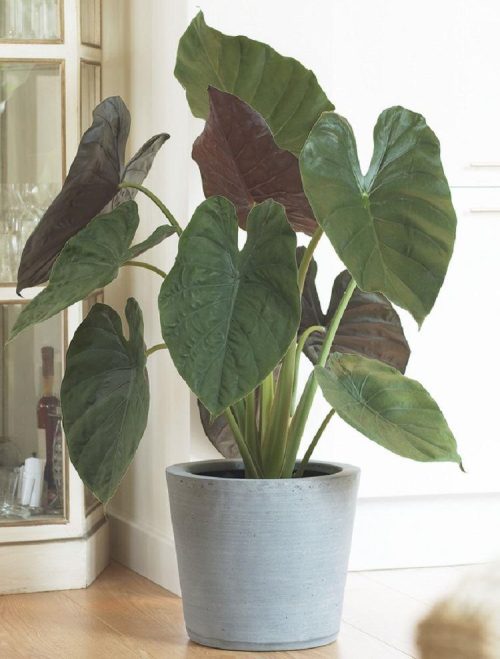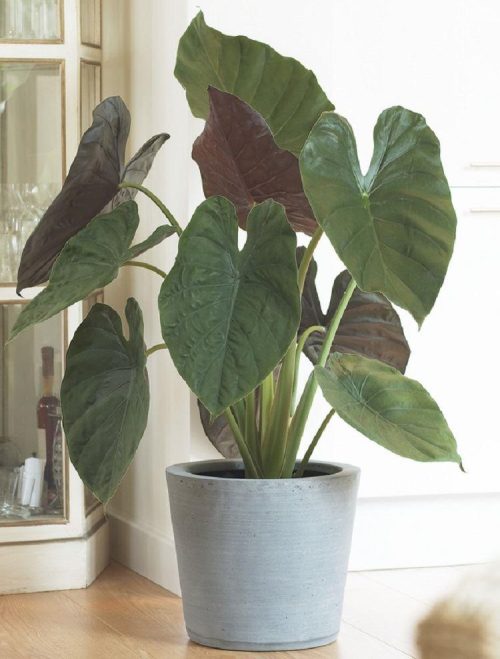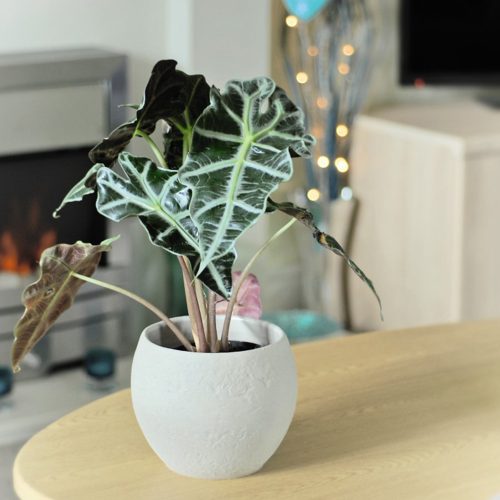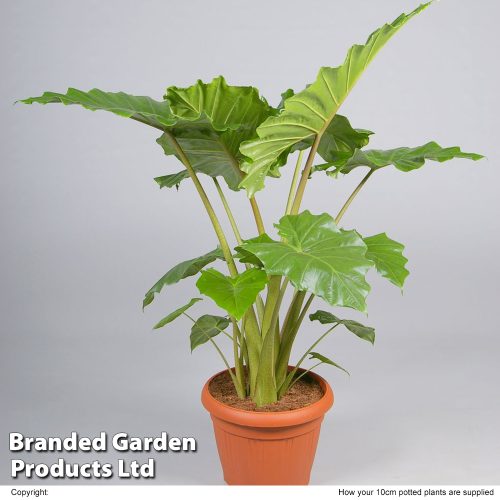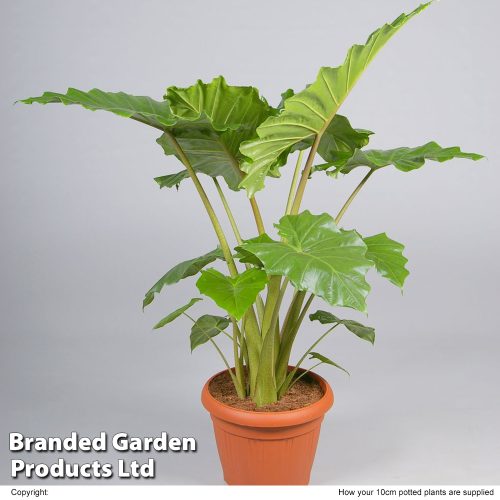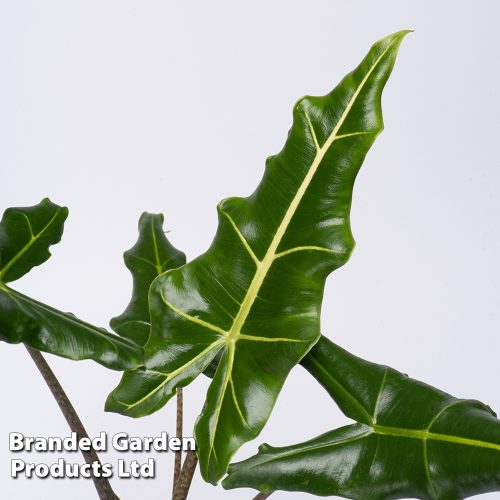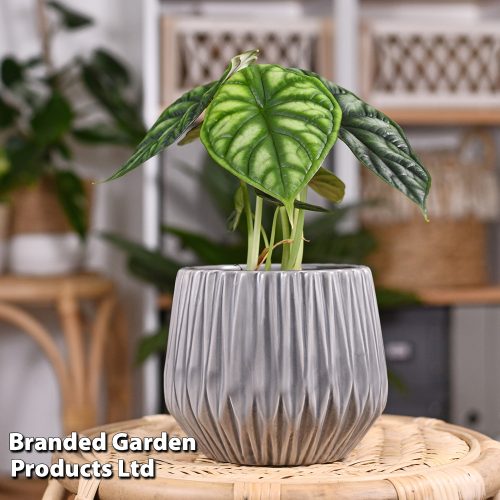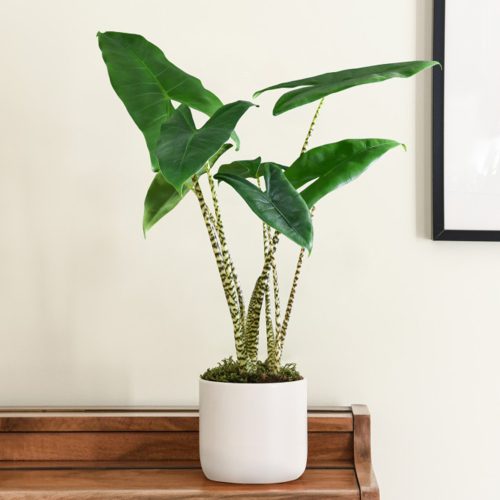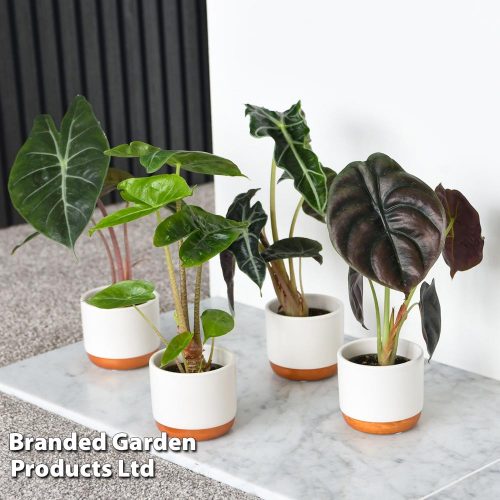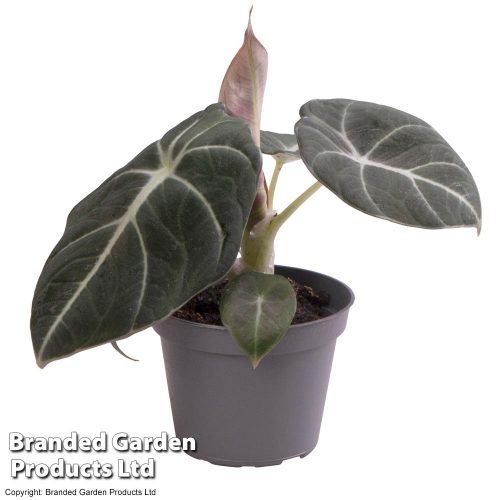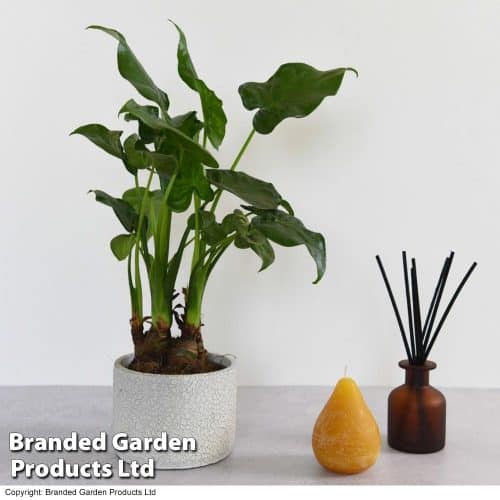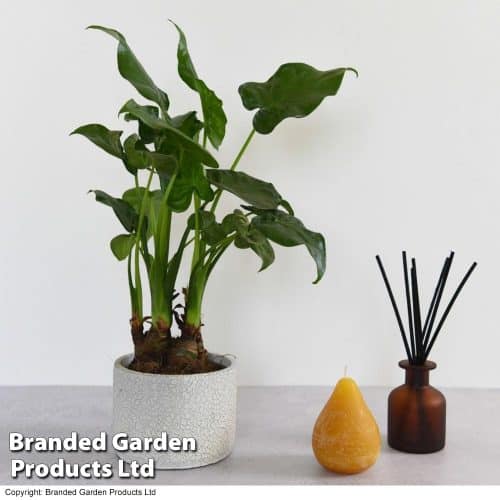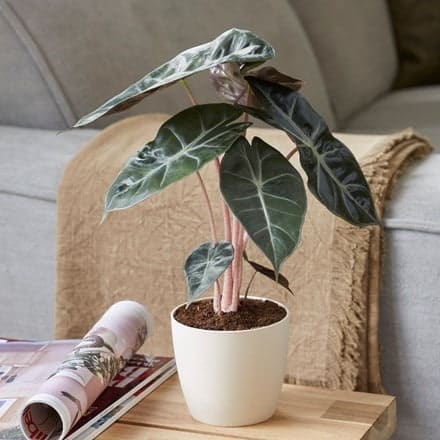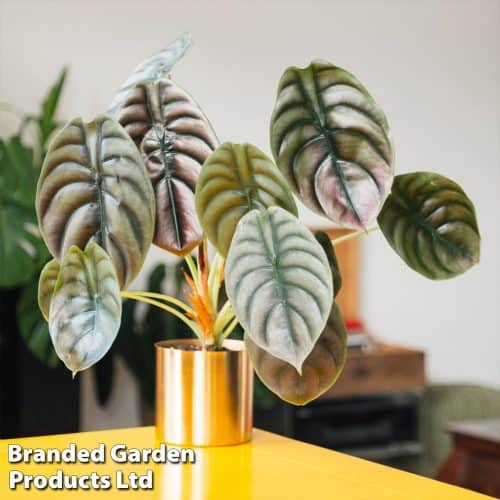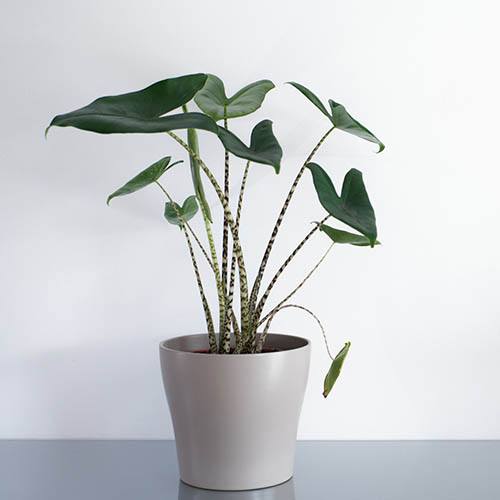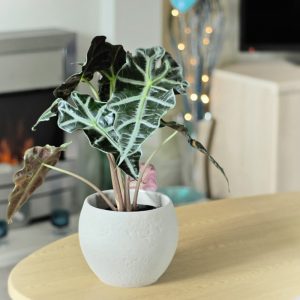
Alocasia amazonica
Alocasia for UK Gardens & indoor
A must grow plant for your exotic and tropical garden, Alocasia creates a jungle feel with their massive leaves arching over and well worth the effort to keep them happy through the winter. They are primarily grown for the massive leaves, and grow so fast in just one season providing you keep them well fed and watered! The more sunshine we have through the summer the better. Alocasia Pink Dragon is a great one. Alocasia Stingray is another beauty.
Alocasia are similar to Colocasia, so to read more about Colocasia click here!
Alocasia macrorrhiza
Growth and Care for Alocasia Plants
They grow to about 1.5m in the UK, and prefer part shade and protection from the wind. They are quite happy in pots, but don’t give them too much space. Plant them outside at the end of May, as you really don’t want to risk frosts.
Alocasia are not hardy, so lift them before the frosts towards the back end of October like the other tender plants, clean them off and stuff in small pot. Keep them above 5c through the winter and barely moist.
It is usually in summer that new leaves are produced each week on an alocasia plant with each new leaf being bigger than the leaves from earlier weeks. Although, the leaves may also vary in texture, width and shape.
Soil: Slightly acidic soil types are the preferences of Alocasia plants. Alocasia should be planted in soil that drains well, preferably crumbly loamy soil and can be planted in potting mix.
Light: Alocasia plants require shade to full sunlight, dependent on the species and variety. Variants of the plants that are sun-trained tend to have better leaf colours from growing in more light. The larger ones can be trained to handle the full tropical sun. Most species can survive in shade, but can always appreciate slightly brighter sunlight that is filtered.
Water: Alocasia plants are water-loving plants, and should be watered when the top of the soil is nearly dry. When indoors they should be kept moist but not soggy, and allow the topsoil to dry out between watering periods. During the dormant winter period, less water is required.
Temperature and Humidity: Alocasia plants typically require a very humid environment to thrive at warmer temperatures.
Alocasia – a more detailed background
Alocasias are tall, big-leafed plants from the Araceae family. They are native to the tropical rainforests of south-east Asia and are known to be household plants. They have around 80 to 97 species and numerous cultivars, with most of them offering herbaceous and ornamental purposes. Although others have similar appearance and growth habitat.
Commonly referred to as Elephant ears, this plant is found to have its natural habitat on the forest floor, just under the tree canopy. Its broad upright leaves shaped like a heart or an arrowhead, are attached to long petioles and can grow to a length of 35 inches. Capable of growing to almost over three feet (depending on the species), the plant tends to be smaller when cultivated as a seasonal plant.
Alocasia is a perennial, fragrant and attractive flowering plant. Although primarily grown as foliage plants, its blooming nature is uncommon in the Midwest and inconspicuous in other areas- as it’s normally hidden under the foliage. Its fruits are usually globular green or yellow berries that contain several seeds.
What are the common species of Alocasia
- Alocasia zebrina: Alocasia zebrina is a tropical species with large leaves and zebra-like stems. This species is unique for its shield-shaped foliage and its absence of white leaf veins as spotted in other plants of the genus. Its petioles are spotted in black and yellow stripes like that of a zebra.
Alocasia zebrina ‘Reticulata’ is an unusual variegate of the Alocasia zebrina species with the same zebra-print pattern and leaf characterised by net-like reticulation which is not present in other Alocasia plants.
Here is a massive list of all alocasia I could find!
Both of these species can grow to a maximum height of 3 feet, with the width of the same measurement.
- Alocasia amazonica: Alocasia amazonica is a tropical foliage plant popularly known as Alocasia ‘Polly’, its other names are African mask plant or Kris plant. This variant is a result of the hybrid cultivation of Alocasia longiloba and Alocasia sanderiana native to tropical Asia.
Alocasia ‘Polly’ is a beautiful ornamental plant with narrow, dark green leaves up to 2 feet long, characterized by wavy edges and thick creamy white veins running through them. It is a fairly compact flowering plant, with sporadic yellow flowers, especially in older plants.
Other varieties of this plant species are Alocasia ‘Bambino’- the dwarf-sized plant with deep green leaves adorning purple undersides and silvery green veins; Alocasia ‘Ivory Coast’- the hybrid cultivation of Alocasia amazonica and Alocasia ‘Aurora’ does not have wavy leaves but has bright pink petioles and brown streaks. This variant grows fast and is well-branched, and grows fast as it can grow to a height of 3 to 4 feet and a width of 2 to 3 feet.
- Alocasia wentii: Alocasia wentii is also known as Went’s elephant ears, Hardy elephant ears or Giant elephant ears. It has large, glossy deep green leaves with purple undersides and an elongated tip. This variety can be 3 to 4 feet tall when fully grown, while its leaves can span up to 3 feet in height.
- Alocasia dragon scale: Alocasia dragon scale is a species of Alocasia known as Alocasia baginda boasting of stunning silvery green leaves with deep green primary and secondary veins resembling large scales. The leaves are slightly hardened like actual scales with cream and burgundy veins in the undersides. This species can grow up to 3 feet in height and about half that size in width.
- Alocasia frydek: Alocasia frydek is a species of Alocasia known as Alocasia micholitziana, and otherwise referred to as Green velvet Alocasia. This species is similar to Alocasia ‘Polly’ in the appearance of its size and leaves, but not as common commercially. It is distinguished by its velvety dark green leaves, wavy edges and glowing white veins; as opposed to the glossy appearance of the other species. It is a medium-sized, narrow plant that can grow up to 2 to 3 feet tall when mature.
FAQ
Can you propagate Alocasia in water?
I think you’re better off finding a colocasia here, as I don’t think Alocasia’s are a great choice here.
How do you propagate Alocasia amazonica?
Alocasia amazonica is best propagated by dividing the corms or digging them up to be replanted.
Is Alocasia an indoor plant too?
Yes, as long as they get enough humidity and light.
How do you care for Alocasia black velvet?
Avoid repotting frequently. Good draining soil, moisture, moderate to indirect light and frequent watering.
How do you look after an Alocasia plant?
Consistently moisture, avoid bright prolonged direct light and keep almost dry during winter.

